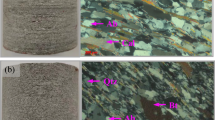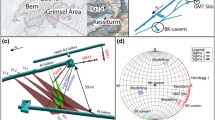Abstract
We investigate the influence of foliation orientation and fine-scale folding on the static and dynamic elastic properties and unconfined strength of the Poorman schist. Measurements from triaxial and uniaxial laboratory experiments reveal a significant amount of variability in the static and dynamic Young’s modulus depending on the sample orientation relative to the foliation plane. Dynamic P-wave modulus and S-wave modulus are stiffer in the direction parallel to the foliation plane as expected for transversely isotropic mediums with average Thomsen parameters values 0.133 and 0.119 for epsilon and gamma, respectively. Static Young’s modulus varies significantly between 21 and 117 GPa, and a peculiar trend is observed where some foliated sample groups show an anomalous decrease in the static Young’s modulus when the symmetry axis (x3-axis) is oriented obliquely to the direction of loading. Utilizing stress and strain relationships for transversely isotropic medium, we derive the analytical expression for Young’s modulus as a function of the elastic moduli E1, E3, ν31, and G13 and sample orientation to fit the static Young’s modulus measurements. Regression of the equation to the Young’s modulus data reveals that the decrease in static Young’s modulus at oblique symmetry axis orientations is directly influenced by a low shear modulus, G13, which we attribute to shear sliding along foliation planes during static deformation that occurs as soon as the foliation is subject to shear stress. We argue that such difference between dynamic and static anisotropy is a characteristic of near-zero porosity anisotropic rocks. The uniaxial compressive strength also shows significant variability ranging from 21.9 to 194.6 MPa across the five sample locations and is the lowest when the symmetry axis is oriented 45° or 60° from the direction of loading, also a result of shear sliding along foliation planes during static deformation.

















(borehole diagram adapted from Morris et al. 2018)
Similar content being viewed by others
Abbreviations
- θ :
-
Angle between symmetry axis and the wave propagation direction or the loading direction
- ρ :
-
Density
- X 3 :
-
Axis of rotational symmetry
- E :
-
Young’s modulus
- ν :
-
Poisson’s ratio
- G :
-
Shear modulus
- M :
-
P-wave modulus
- N :
-
Constant used in equations for VP, VSV, VSH
- σ Ax. Diff :
-
Axial differential stress (total stress-confining pressure)
- P C :
-
Confining pressure
- ε :
-
Strain when discussed with stress or compliance and stiffness
Thomsen parameter describing the difference in the P-wave velocities measured parallel and perpendicular to the symmetry axis, normalized by the velocity at θ = 0°
- C :
-
Stiffness matrix
- c ijkl :
-
Components of the stiffness tensor
- S :
-
Compliance matrix
- s ijkl :
-
Components of the compliance tensor
- VP, VSV, VSH :
-
Compressional, vertical shear, and horizontal shear velocities
- α, βThom :
-
Thomsen parameters that describe VP and VSH, respectively, for perpendicular orientation
- γ :
-
Thomsen parameter that describes the difference in VSH measured parallel and perpendicular to the symmetry axis, normalized by the velocity at θ = 0°
- δ :
-
Thomsen parameter used with α to describe the normal moveout of VP
- σ c :
-
Uniaxial compressive strength
- A, B :
-
Constants describing the variation in uniaxial compressive strength
- θ min :
-
Orientation of minimum uniaxial compressive strength for each planar sample group
References
Amadei B (1996) Importance of anisotropy when estimating and measuring in situ stresses in rock. Int J Rock Mech Min Sci Geomech Abstr. https://doi.org/10.1016/0148-9062(95)00062-3
Attewell PB, Sandford MR (1974) Intrinsic shear strength of a brittle, anisotropic rock—I: Experimental and mechanical interpretation. Int J Rock Mech Min Sci Geomech Abstr. https://doi.org/10.1016/0148-9062(74)90453-7
Frash LP, Welch NJ, Carey JW; The EGS Collab Team (2019) Geomechanical evaluation of natural shear fractures in the EGS Collab Experiment 1 test bed. In: 53rd US rock mechanics/geomechanics symposium, New York, June 23–26, 2019, ARMA, pp 1819–1829
Homand F, Morel E, Henry JP, Cuxac P, Hammade E (1993) Characterization of the moduli of elasticity of an anisotropic rock using dynamic and static methods. Int J Rock Mech Min Sci Geomech Abstr 20:527–535. https://doi.org/10.1016/0148-9062(93)92218-F
Jaeger JC (1960) Shear failure of anisotropic rocks. Geol Mag 97:65–72. https://doi.org/10.1017/S0016756800061100
Jones LEA, Wang HF (1981) Ultrasonic velocities in Cretaceous shales from the Williston basin. Geophysics 46:288–297
Kneafsey TJ, Blankenship D, Knox HA et al (2019) EGS Collab Project: status and progress. In: 44th workshop on geothermal reservoir engineering, Stanford University, Stanford, February 11–13, pp 1–16
Mavko G, Mukerji T, Dvorkin J (2009) The rock physics handbook: tools for seismic analysis of porous media. Cambridge University Press, Second
McLamore R, Gray KE (1967) The mechanical behavior of anisotropic sedimentary rocks. J Eng Ind 89:62–78. https://doi.org/10.1115/1.3610013
Moore DE, Lockner DA (2004) Crystallographic controls on the frictional behavior of dry and water-saturated sheet structure minerals. J Geophys Res. https://doi.org/10.1029/2003jb002582
Morris JP, Fu P, Dobson P et al (2018) Experimental design for hydrofracturing and fluid flow at the DOE EGS collab testbed. In: 43rd workshop on geothermal reservoir engineering, Stanford University, Stanford, February 12–14, pp 1–11
Nasseri MHB, Rao KS, Ramamurthy T (2003) Anisotropic strength and deformational behavior of Himalayan schists. Int J Rock Mech Min 40:3–23. https://doi.org/10.1016/S1365-1609(02)00103-X
Nur A, Simmons G (1969) Stress-induced velocity anisotropy in rock: an experimental study. J Geophys Res 74:6667–6674. https://doi.org/10.1029/jb074i027p06667
Nye JF (1985) Physical properties of crystals. Oxford University Press, Oxford
Oldenburg CM, Dobson PF, Wu Y, et al (2017) Hydraulic fracturing experiments at 1500 m depth in a deep mine: highlights from the kISMET project. In: 42nd workshop on geothermal reservoir engineering. pp 1–9
Ramamurthy T, Rao GV, Singh J (1993) Engineering behaviour of phyllites. Eng Geol 33:209–225. https://doi.org/10.1016/0013-7952(93)90059-L
Read SAL, Perrin ND, Brown IR (1987) Measurement and analysis of laboratory strength and deformability characteristics of schistose rocks. In: Proceedings of the sixth international conference on rock mechanics, Montreal, vol 1, pp 233–238
Saeidi O, Rasouli V, Geranmayeh Vaneghi R et al (2014) A modified failure criterion for transversely isotropic rocks. Geosci Front 5:215–225. https://doi.org/10.1016/j.gsf.2013.05.005
Sayers CM (2010) The effect of anisotropy on the Young’s moduli and Poisson’s ratios of shales. In: SEG Denver 2010 annual meeting, pp 2606–2611
Sone H, Zoback MD (2013) Mechanical properties of shale-gas reservoir rocks—Part 1: Static and dynamic elastic properties and anisotropy. Geophysics 78:D381–D392. https://doi.org/10.1190/GEO2013-0050.1
Thomsen L (1986) Weak elastic anisotropy. Geophysics 51:1954–1966. https://doi.org/10.1190/1.1442051
Vigilante P (2017) Rock mechanics laboratory tests relevant to the in-situ stress measurements at the 4850-level, Homestake Mine, Lead, South Dakota. M.S. thesis, University of Wisconsin-Madison
Walsh JB, Brace WF (1964) A fracture criterion for brittle anisotropic rock. J Geophys Res. https://doi.org/10.1029/JZ069i016p03449
Wang HF, Lee MY, Doe TW, Haimson BC, Oldenburg CM, Dobson PF (2017) In situ stress measurement at 1550-meters depth at the kISMET test site. In: Lead SD (eds) 51st U.S. rock mechanics/geomechanics symposium, San Francisco, CA, 25–28 June 2017, ARMA 17–651
Acknowledgements
This material was based upon work supported by the U.S. Department of Energy, Office of Energy Efficiency and Renewable Energy (EERE), Office of Technology Development, and Geothermal Technologies Office under Award Number DE-AC02-05CH11231 with LBNL. The United States Government retains, and the publisher, by accepting the article for publication, acknowledges that the United States Government retains a non-exclusive, paid-up, irrevocable, world-wide license to publish or reproduce the published form of this manuscript, or allow others to do so, for United States Government purposes. The research supporting this work took place in whole or in part at the Sanford Underground Research Facility in Lead, South Dakota. The assistance of the Sanford Underground Research Facility and its personnel in providing physical access and general logistical and technical support is acknowledged. We thank Megan Smith for providing XRD mineralogy results of the samples used in this study.
Author information
Authors and Affiliations
Consortia
Corresponding author
Ethics declarations
Conflict of interest
The authors declare that they have no conflict of interest.
Additional information
Publisher's Note
Springer Nature remains neutral with regard to jurisdictional claims in published maps and institutional affiliations.
Appendices
Appendix A: Analytical Expression for Young’s Modulus of Rotated TI Mediums
1. Uniaxial stress is applied in the x3-direction making σ33 the only nonzero stress in the initial x1–x3 coordinate system.
2. Rotate the stress matrix about the x2-axis to the x1′–x3′ coordinate system. The rotation matrix, R, is given from the direction cosines between the initial and prime axis.
3. Rewrite the rotated stress matrix in Voigt notation and multiply the compliance matrix by the rotated stress matrix to find the strain in the prime coordinate system.
4. Rotate the strain tensor back to the initial coordinate system using the inverse rotation matrix R−1.
The individual components of the resulting strain matrix are written in the equations below:
5. The Young’s modulus is determined from dividing the applied stress by strain in the same direction
and can be written in the following convenient form by substituting the compliance matrix components.
where for a transverse isotropic material with symmetric axis in the three directions
Appendix B: Sample Locations and Borehole Diagram
Figure 17 shows the borehole diagram along the west drift on the 4850-ft depth level of SURF adapted from Morris et al. (2018) with discs that indicate the intended notch locations for hydraulic stimulation in the EGS Collab project. The testbed is comprised of eight sub-horizontal boreholes oriented around the intended stimulation zone. Sample locations are marked with a square for the planar sample groups and a circle for the folded sample groups. Sample names are assigned based on the borehole and sample orientation. The first letters (P, I, OB, or PDB) indicate the borehole and the second numbers or letters (ex: 0, 45, X, Z) indicate the sample orientation. The sample depths along the length of the borehole are provided in Table
7.
Appendix C: Ultrasonic Velocity and Static Young’s Modulus Table
See Tables 8 and
9.
Rights and permissions
About this article
Cite this article
Condon, K.J., Sone, H., Wang, H.F. et al. Low Static Shear Modulus Along Foliation and Its Influence on the Elastic and Strength Anisotropy of Poorman Schist Rocks, Homestake Mine, South Dakota. Rock Mech Rock Eng 53, 5257–5281 (2020). https://doi.org/10.1007/s00603-020-02182-4
Received:
Accepted:
Published:
Issue Date:
DOI: https://doi.org/10.1007/s00603-020-02182-4




